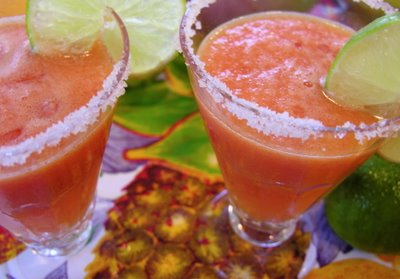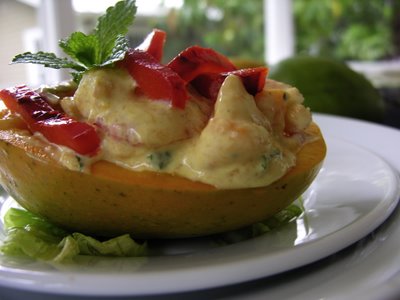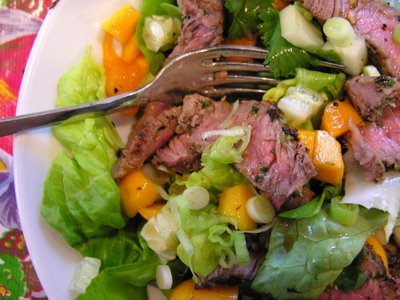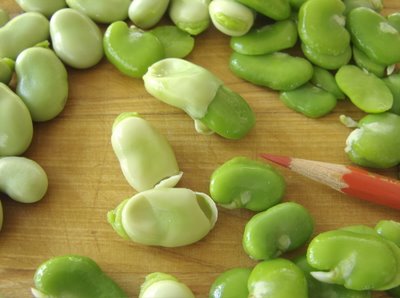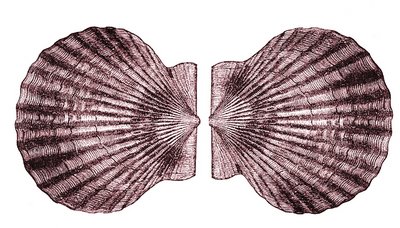 Yes we have mangos today. We are fortunate to have a tree in the yard that likes us. We know this because we were rewarded with a prolific bounty this year. To tell the truth the tree has provided us with mangoes for well over a month, and when they are gone we will miss them. The first ones of the season we ate fresh, the very first one I heralded into the kitchen with great fan fare announcing that we had a ripe mango, thus the season of mangos began. The sweet tart taste of the first mango always brings with it summer memories. Moving on into the season the mangoes ripen in waves of ten to twenty at a time, now our friends and neighbours look forward to suckling on the sweet fruit. Freezing temporarily helps to preserve the bounty, but now the freezer is full and the mangoes keep coming. Smoothies, salsas, mango preserves and fruit salads roll off the tree, and still more mangoes. With the aid of the“Great Mango Book” and the “Trade Winds Cookery” cook book, I managed to open my perception to what Mangos could be. With that stated here are our favourite and most successful recipes of the summer. Just one more thing, when putting your head into these recipes remember that mango is sometimes referred to as the “peach of the tropics”.
Yes we have mangos today. We are fortunate to have a tree in the yard that likes us. We know this because we were rewarded with a prolific bounty this year. To tell the truth the tree has provided us with mangoes for well over a month, and when they are gone we will miss them. The first ones of the season we ate fresh, the very first one I heralded into the kitchen with great fan fare announcing that we had a ripe mango, thus the season of mangos began. The sweet tart taste of the first mango always brings with it summer memories. Moving on into the season the mangoes ripen in waves of ten to twenty at a time, now our friends and neighbours look forward to suckling on the sweet fruit. Freezing temporarily helps to preserve the bounty, but now the freezer is full and the mangoes keep coming. Smoothies, salsas, mango preserves and fruit salads roll off the tree, and still more mangoes. With the aid of the“Great Mango Book” and the “Trade Winds Cookery” cook book, I managed to open my perception to what Mangos could be. With that stated here are our favourite and most successful recipes of the summer. Just one more thing, when putting your head into these recipes remember that mango is sometimes referred to as the “peach of the tropics”.  Mango jelly, relish and leather are some of the many things we made with our mangos this summer.
Mango jelly, relish and leather are some of the many things we made with our mangos this summer.Mango-Lime Relish
This recipe is verbatim courtesy of the “Trade Winds Cookery” by Norma Davis copyright 1956. I feel no need to change a thing, this relish is easy to make and complements grilled meats superbly, I even found it to be delicious over plain
white rice.
Peel and slice the mangoes thinly. Make a syrup of the lime juice and sugar. Add other ingredients and cook until the syrup is thick and the fruit transparent. Seal immediately. Other seasonings can be added as desired. (* I made a batch using whole cloves and whole allspice berries, currently I am wating to see how the flavors meld)
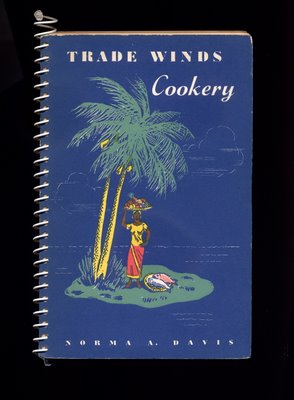 The Trade Winds Cookery: Tropical Recipes for All America was published in 1956 and was a cookbook designed to bring awareness to foods that were becoming available by means of modern transportation and marketing.
The Trade Winds Cookery: Tropical Recipes for All America was published in 1956 and was a cookbook designed to bring awareness to foods that were becoming available by means of modern transportation and marketing.Mango Leather
This recipe was adapted from “The Great Mango Book” by Allen Susser
This tasty treat can be made while you sleep. If you have kids that are interested in cooking, mango leather is easy and fun to make with a minimal amount of mess and results are guaranteed. Please note the changes, ( * designates my changes) I found this recipe has some faults. Mango leather is wide open for experimentation.
Makes one 14 inch roll, approximately
Preheat the oven to 225 degrees. (* This is where I get off the bus and leave the author behind. 225 degrees is much to hot. Start your oven at 200 degrees for 2 hours then reduce to 170 degrees for 8 to 10 hours. I have an electric range and this formula works perfect for me)
In a food processor purée the mangos until smooth. Add the lemon juice and sugar. Puree until the sugar is dissolved.
Dampen a rimmed pan (*wipe with damp cloth ) and line it with sheets of plastic film large enough to overlap the edges. (*The plastic wrap will not melt, try and keep wrinkles to a minimum)
Pour the mango mixture onto the lined pan. By tipping and tilting the tray, spread it out into an even layer (*Spread it with a spatula then tap) about 1/4 inch thick.
Place in the oven for 12 to 14 hours, (* 8 to 10 hours works for me) or until dry but pliable. Remove from the oven and cool. Peel the leather off the plastic film and transfer to a sheet of waxed paper. Roll the leather up into a cylinder. Store in an
airtight container for up to 2 weeks. (* Peel from plastic while warm and transfer to cutting board and cut into strips with a pizza wheel cutter, wrap in plastic wrap squares and twist ends)
 Finished mango leather coming out of the oven
Finished mango leather coming out of the oven Cutting and rolling the warm strips
Cutting and rolling the warm stripsAdditional cooks notes:
The taste, texture, chewiness of the leather can be adjusted to your preference. The first time I made mango leather I used the recipe in the Mango book, following the instructions for 225 degree temperature at 12 hours, I ended up with mango brittle. I have since found that when the time and temperature are reduced the fruit retains more of its flavour and a soft body. To say it another way, the lower temperature results in a mango leather of surprising succulence. You do want the finished leather to be dried out enough to be peeled off the plastic wrap in a single sheet. To test for doneness peel from one end, the leather should not tear as you do this. Transfer to a cutting board and with a pizza wheel cutter divide into strips to suit your needs. Roll up strips and then wrap individually in wax paper. The author claims that the leather will keep for two weeks, if you can resist it!
A Successful Variation; Mango Coconut, Rum Leather
Purée mango in batches in food processor with sugar, lime juice and rum
Press through kitchen strainer into large bowl.
Add coconut flakes a little at a time stirring to mix throughout.
Divide between two plastic wrap lined baking sheets.
Start the leather at 200 degrees for 2 hours.
Reduce temperature to 170 degrees for 8 to 10 hours.
Peel off plastic wrap cut roll and wrap individual pieces with wax paper.



